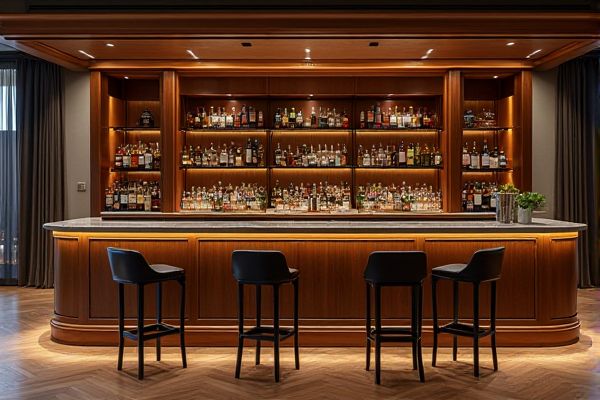
A wet bar features a sink with running water, making it ideal for mixing cocktails and easy cleanup, while a dry bar lacks plumbing and is better suited for serving drinks and storage without water-related maintenance. Explore the differences and benefits to decide which bar setup best complements your entertaining style and space.
Table of Comparison
| Feature | Wet Bar | Dry Bar |
|---|---|---|
| Definition | Bar area with a sink and plumbing for water access | Bar area without plumbing or a sink |
| Plumbing | Included; has water supply and drainage | Not included; no water supply or drainage |
| Installation Cost | Higher due to plumbing and fixtures | Lower; simpler setup |
| Maintenance | Requires sink care, potential plumbing repairs | Minimal; mainly cleaning and restocking |
| Functionality | Can wash glasses, mix drinks with running water | Primarily for drink preparation and serving |
| Space Requirement | Needs more space for sink and plumbing | Compact; ideal for smaller areas |
| Location Flexibility | Limited to areas with plumbing access | Flexible; can be placed almost anywhere |
| Typical Use | Homes, entertainment rooms requiring full bar setup | Small apartments, offices, or casual entertaining |
Introduction to Wet Bars and Dry Bars
Wet bars feature sinks with running water, allowing convenient rinsing and beverage preparation, while dry bars lack plumbing and focus on storage and display of drinkware and spirits. Your choice depends on space availability, plumbing access, and usage preferences for entertaining or casual drinking. Wet bars often require more installation effort but offer enhanced functionality compared to the simpler, low-maintenance dry bars.
Key Differences Between Wet Bar and Dry Bar
A wet bar features a sink with running water, facilitating beverage preparation and cleaning, while a dry bar lacks a sink and is primarily designed for storing and serving drinks. Wet bars require plumbing installation, making them more complex and usually suitable for larger spaces, whereas dry bars offer flexibility in placement without the need for water connections. The choice between wet and dry bars depends on functionality requirements, space availability, and budget considerations.
Unique Features of a Wet Bar
A wet bar is uniquely equipped with a sink and plumbing, allowing for easy washing of glassware and preparation of drinks involving water or ice. It typically includes a built-in faucet, drainage system, and sometimes a mini refrigerator, making it a versatile space for cocktail mixing. These features distinguish wet bars from dry bars, which lack plumbing and focus primarily on storage and display.
Defining Characteristics of a Dry Bar
A dry bar is characterized by the absence of running water and plumbing, making it primarily a space for storing and serving alcoholic beverages without a sink or faucet. It typically includes shelves or cabinets for glassware and liquor bottles, along with counter space for mixing drinks and preparing garnishes. Unlike a wet bar, a dry bar is easier to install and maintain due to its simpler design and does not require plumbing connections.
Functional Benefits of Wet Bars
Wet bars offer the functional benefit of having a dedicated water source, which simplifies the preparation of cocktails, cleaning of glassware, and availability of fresh ice. Your entertaining experience is enhanced through the convenience of a sink, allowing for efficient rinsing and minimizing messes during gatherings. This setup supports a wide variety of beverage options, making your bar area more versatile and practical compared to a dry bar.
Advantages of Choosing a Dry Bar
A dry bar offers the advantage of lower maintenance since it does not require plumbing or drainage, making it easier to install and less costly. It provides flexibility in design and location, suitable for spaces where water access is limited or not desired. Dry bars encourage creativity with mixology while minimizing the risk of water-related damage to furniture and flooring.
Space and Installation Requirements
A wet bar requires plumbing for a sink and water supply, making it ideal for homes with existing water lines and more spacious areas to accommodate piping and drainage. Dry bars need less space and simpler installation since they rely on shelves or cabinets for storage without water hookups. Both options benefit from thoughtful layout design, but wet bars typically demand more extensive space and construction work.
Cost Comparison: Wet Bar vs Dry Bar
A wet bar typically costs more than a dry bar due to the need for plumbing installation, water supply, and drainage systems, which can add several thousand dollars to your renovation budget. Dry bars are more budget-friendly, requiring only cabinetry, countertops, and storage without the expense of sinks or tap fittings. Your choice depends on whether the higher investment in a wet bar aligns with your entertainment style and plumbing feasibility.
Ideal Locations for Wet and Dry Bars at Home
Wet bars are ideal for kitchens, basements, or outdoor patios where plumbing access allows for sinks and refrigeration, enhancing functionality and convenience. Dry bars fit well in living rooms, dining areas, or dens where space is limited and storing only bottles, glassware, and mixers suffices. Your choice depends on available space and whether you prefer a fully equipped wet bar or the simplicity of a dry bar for entertaining guests.
Choosing the Right Bar for Your Lifestyle
Wet bars include sinks and plumbing, making them ideal for those who frequently entertain and prefer preparing cocktails with fresh ingredients and easy cleanup. Dry bars, lacking running water, suit smaller spaces or casual use, offering simplicity and lower installation costs while still providing storage and display for beverages. Selecting between wet and dry bars depends on your entertaining habits, available space, and willingness to invest in plumbing infrastructure.
 homyna.com
homyna.com